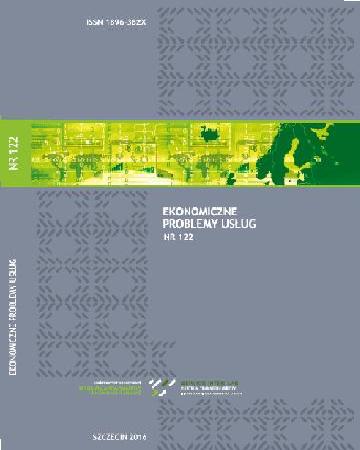
ISSN: 1896-382X
eISSN: 2353-2866
OAI
DOI: 10.18276/epu.2018.132-13



Issue archive /
nr 132 2018
Financial obstacles for new enterprises: industry differences and the dynamic of changes
| Authors: |
Danuta
Zawadzka
Politechnika Koszalińska Wydział Nauk Ekonomicznych Agnieszka Kurdyś-Kujawska Politechnika Koszalińska Wydział Nauk Ekonomicznych Agnieszka Sompolska-Rzechuła Zachodniopomorski Uniwersytet Technologiczny w Szczecinie Wydział Ekonomiczny |
| Keywords: | financial barriers start-ups bank loans collection of receivables |
| Data publikacji całości: | 2018-09-27 |
| Page range: | 12 (149-160) |
| Klasyfikacja JEL: | L23 M13 |
Abstract
Aim of the article – identification and the assessment of diversity in occurrences of financial barriers limiting the functioning of newly established enterprises in Poland by their activity type. Research methods – a thesis has been put forward that the intensification of occurrences of financial barriers limiting the functioning of newly established enterprises is diversified according to their activity type. The study uses Central Statistical Office (CSO) data for the years 2005–2014. Source material comprised data on the percentage of newly created enterprises that were active one year after the beginning of operations, according to the reported supply difficulties and according to selected cross-sections. In order to identify industries with similar tendencies of financial obstacles limiting their operations, the method of multidimensional comparative analysis (MCA) was used, including the k-means method which is classified as an optimization method. Results – lack of sufficient financial resources is indicated by the owners of newly established enterprises as one of the main and often the most important barrier to running and developing business operations. In the years 2005–2014, in the majority of analyzed industries, the percentage of newly established enterprises whose activity was limited due to a lack of sufficient financial resources increased on average, and the percentage indicating that the barriers limiting their functioning and development are difficulties in collection of receivables, as well as the access to bank loans was decreasing. In the analyzed period, the percentage of newly established enterprises operating in particular industries was diversified significantly in terms of the average pace of changes in the occurrence of certain financial obstacles limiting their functioning. Innovation/value – the value of the article is to indicate the variation in the scale and dynamics of changes in the financial barriers
faced by newly established enterprises, which may contribute to creating better conditions for start-ups.
Download file
Article file
Bibliography
| 1. | Antonowicz, P. (2010). Procesy upadłościowe przedsiębiorstw w Polsce. Raport z badań, Konferencja Przedsiębiorstw Finansowych w Polsce – Związek Pracodawców. Warszawa–Gdańsk: Europejski Rejestr Informacji Finansowej – BIG SA, Kruk SA. |
| 2. | Białowolski, P., Łaszek, A. (2017). Zatory płatnicze: duży problem dla małych firm. Warszawa: Fundacja Formu Obywatelskiego Rozwoju – FOR. |
| 3. | Bojec, S. (2002). Payments, Insolvency and Finance during Economic Transformation: Slovenia on the Way to European Union Accession. Europe–Asia Study, 54 (2), 277–297. |
| 4. | Fielden, S.L., Davidson, M.J., Makin, P.J. (2000). Barriers encountered during micro and small business start-up in North-West England. Journal of Small Business and Enterprise Development, 7 (4), 295–304. DOI: 10.1108/EUM0000000006852. |
| 5. | Grabiński, T. (1992). Metody aksonometrii. Kraków: Akademia Ekonomiczna w Krakowie. |
| 6. | Hausemer, P., Rzepecka, J., Lofstrom, F., Eparvier, P., Rivoire, L., Gallo, C., Maroulis, N. (2015). Ex-post Evaluation of Late Payment Directive. Valdani Vicari Associati, Technopolis Group, Ernest & Young, Publications of the European Union.Intrum Justitia (2016). European Payment Report 2016. |
| 7. | Jafarnejda, A., Abbaszadeh, M., Ebrahim, M., Abtahi, S.M. (2013) Analysis barriers to entrepreneurship in Small and Medium-size Enterprises (SMEs). International Journal of Academic Research in Economics and Management Sciences, 2 (4), 07–206. DOI: 10.6007/IJAREMS/v2-i4/155. |
| 8. | Jajuga, K. (1993). Statystyczna analiza wielowymiarowa. Warszawa: Wydawnictwo Naukowe PWN. |
| 9. | Jakubec, V., Solik, J. (2006). Bariery rozvoja podnikatel’skeho prostredia na Slovensku. Scientific letters of Faculty of Chemical and Food Technology, Slovak University of Technology in Bratislava, Management Department, 3, 14–22. |
| 10. | Kazan, M.K., Oksoy, D., Ozsoy, O. (2006). Growth Plans of Small Business in Turkey: Individual and Environmental Influences. Journal of Small Business Management, 4 (11), 114–129. |
| 11. | Lamei, B. (2002). Developing and Training Entrepreneurship in Iran: Barriers and Solutions. Ministry of Labor & Social Affairs, Institute of Labor & Social Security, 1 (45), 26–32. |
| 12. | Malina, A. (2004). Wielowymiarowa analiza przestrzennego zróżnicowania struktury gospodarki Polski według województw. Kraków: Wydawnictwo Akademii Ekonomicznej w Krakowie. |
| 13. | Nowak, E. (1990). Metody taksonomiczne w klasyfikacji obiektów społeczno-gospodarczych. Warszawa: PWE. |
| 14. | Panek, T. (2009). Statystyczne metody wielowymiarowej analizy porównawczej. Warszawa: Szkoła Główna Handlowa w Warszawie. |
| 15. | Sobekova-Majkova, M. (2011). Analyza barier a faktorov financovania malych a strednych podnikov v SR. The analysis of barriers and factors of financing of SME in SR. Journal of Economics, 59 (10), 1018–1032. |
| 16. | Staniewski, M., Awruk, K. (2015). Motivating factors and barriers in the commencement of one’s own business for potential entrepreneurs. Economic Research-Ekonomska Istrazivanja, 28 (1), 583–592. DOI: 10.1080/1331677X.2015.1083876. |
| 17. | Zawadzka, D., Kurdyś-Kujawska, A. (2017). Problemy finansowe kontrahenta jako bariera rozwoju nowo powstałego przedsiębiorstwa – ujęcie branżowe uwarunkowań rynkowych w Polsce. Annales Universitatis Mariae Curie-Skłodowska, Lublin-Polonia, Sectio H, 51 (6), 517–524. |
| 18. | Zawadzka, D., Kurdyś-Kujawska, A. (2018). Znaczenie barier popytowych i podażowych w działalności nowo powstałych w Polsce. Finanse, Rynki Finansowe, Ubezpieczenia, 1 (91), 125–135. DOI: 10.18276/frfu.2018.91-11. |
| 19. | Zhuplev, A., Shtykhno, D. (2009). Motivations and Obstacles for Small Business Entrepreneurship in Russia: Fifteen Years in Transition. Journal of East-West Business, 15 (1), 25–49. |